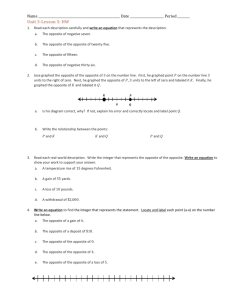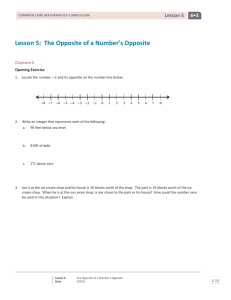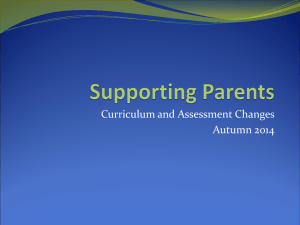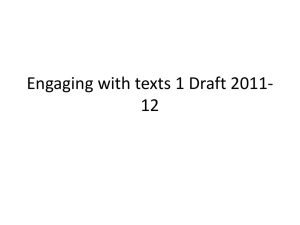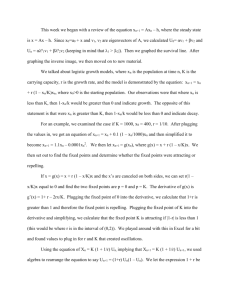SWK 7402. Applied Practice Evaluation
advertisement
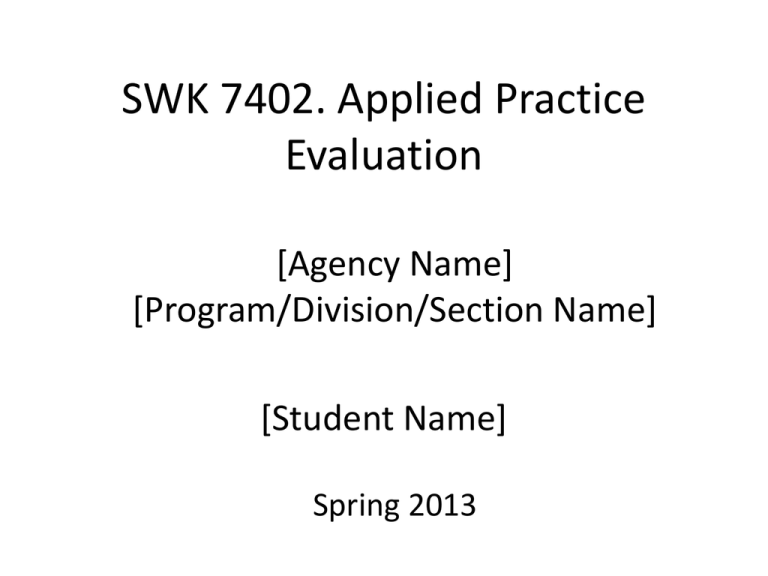
SWK 7402. Applied Practice Evaluation [Agency Name] [Program/Division/Section Name] [Student Name] Spring 2013 ABSTRACT BACKGROUND • Practice setting • Problem(s) • Intervention • Theory METHODS • Clients • Measures • Design • Data collection • Analysis RESULTS • Summary of outcome graphs • Summary of goal attainment data DISCUSSION • Level of support for intervention • Alternative explanations of results • Implications for clinical practice BACKGROUND: Practice Setting • Description of agency – [Public or private agency] – [Services provided] – [Service area] – [Location of office(s)] • Description of program/division/section – [Population(s) served] – [Service(s) provided] BACKGROUND: Problem(s) • [Primary problem facing agency/prog clients] • [Secondary problem facing agency/prog clients] • [Tertiary problem facing agency/prog clients] ---------―[Types] ―[Prevalence] ―[Causes] ―[Common treatment/intervention approaches] BACKGROUND: Intervention • [Intervention/advanced practice method being evaluated] – – – – [Voluntary vs. involuntary] [Individ vs. family vs. group] [Single session/crisis intervention vs. multiple session] [At agency vs. in-home/community] • Key elements – [Element #1] – [Element #2] – [Etc.] Figure 1. (Local) Intervention Theory Increased [faculty] social support Decreased stress Increased well-being Key intervention elements 1. 2. 3. 4. 5. Express interest Validate feelings Share thoughts, suggestions Encourage contact with field liaison Improve teaching, class as-needed 1-5 rating of overall wellbeing BACKGROUND: Theory of Change • [Theory(ies) supporting intervention] • [Brief description] • [Explanation of why/how theory key elements of intervention] Figure 2. C-CEP/Logic Model Elements Condition Targets Intermediate Outcomes Long-term Outcome Problem Objective 1 Objective 2 Goal Financial insolvency • New job • HH income >300/wk Decreased psychological stress • Operational measure? Increased sexual satisfaction • Operational measure? Increased wellbeing of marriage relationship • Operational measure? Propositions & Theories Assumptions • [Specify theory(ies)] Intervention-related activities • [Specify intervention] Inputs, Activities & Outputs METHODS: Clients • [Client/case #1] • [Client/case #2] • [Etc.] ---------―Alias/initials ―Demographics ―Presenting problem(s) METHODS: Measures • [Outcomes: outcome domains/concepts and quantifiable measures to be graphed on y-axis] – [Incl. measurement scale – e.g., 1-5, 0-30, yes/no] • [Intervention: unit of time on x-axis] • [Goal attainment (*) measure(s): overall quantitative rating and/or qualitative explanation] METHODS: Design • [Specify letters – e.g., “(A)B*”] • [Describe, define each letter (one per bullet) such that average helping professional, client, family member etc. may understand] METHODS: Data Collection • [Overall description of logistical details for collecting outcome measures data to be graphed and goal attainment data] – [Data source(s)] – [Collection/compilation time points (e.g., at beginning or end of each day, week in field] – [Instrument(s): print log, Excel spreadsheet] – [Data entry, updating of Excel file in Carmen…for review and monitoring by instructor] METHODS: Analysis • [Analysis method(s) for client outcomes/graph data (e.g., Trend Analysis for all + Nonoverlapping for those able to collect daily data] • [Confirmatory reporting of goal attainment data to help interpret graphed outcomes data] Figure 3. Client Outcomes General Well-being Excellent 5.0 4.5 Good 4.0 3.9 3.3 3.5 Average 3.5 3.4 3.5 3 4 5 3.6 3.8 3.5 3.4 9 10 3.2 3.0 2.5 Fair 2.0 1.5 Poor 1.0 1 2 6 Week 7 8 RESULTS: Graphed Outcomes Data • [“Story” told by trend lines (and nonoverlapping, if applicable) from Results graphs] – [Possibly one bulleted summary per outcome] RESULTS: Goal Attainment Data • [Quantitative rating(s) (e.g., 1-5)] – [Overall…and possibly specific areas/topics/issues] • [Qualitative “themes”, reasons, etc. which emerged from explanations of ratings provided by clients while discussing graphed outcomes vs. current life experience] DISCUSSION: Support for Intervention • [Overall level of support for intervention based on results (e.g., none, weak, medium, strong) • [Provision of specific facts/results supporting overall level of support claim made above] DISCUSSION: Alternative Explanations • [1st alternative explanation of observed results] • [2nd alternative explanation] • [3rd alternative explanation] ---------―[Naturally occurring “regression to mean”, or normal, after time of crisis, episode, etc.] ―[Invalid, possibly over simplistic, measures] ―[Insufficient time and/or intensity of intervention to observe change within 10-week eval period] ―[Insufficient or unavail. baseline data to compare] DISCUSSION: Implications for Practice • [Lessons learned and/or questions raised for your own professional practice from these practice evaluation data]
